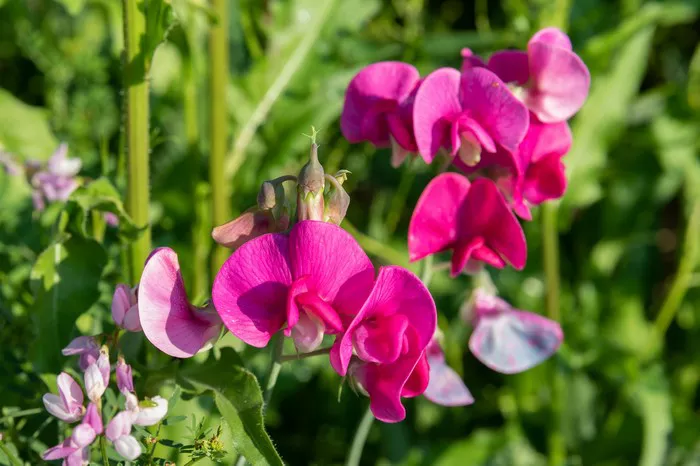Sweet peas, known scientifically as Lathyrus odoratus, belong to the Fabaceae family. These annual climbing plants are native to Sicily, Cyprus, and southern Italy, and they have been cultivated for centuries for their ornamental value. With their vibrant hues and pleasant scent, sweet peas have become a staple in gardens and floral displays, often adorning fences, trellises, and bouquets.
While these flowers are undoubtedly appealing to humans, the potential threat they pose to our canine companions requires careful consideration.
Toxic Components
The concern with sweet peas lies in certain compounds present in the plant, specifically lathyrogens. Lathyrogens are naturally occurring chemicals found in various plants, and they can have adverse effects on both humans and animals when ingested.
In sweet peas, lathyrogens are concentrated in higher amounts in the seeds rather than the flowers themselves. Nevertheless, it’s essential to be aware that all parts of the plant contain these compounds to some extent, including the flowers, leaves, and stems.
Potential Risks for Dogs
When a dog ingests sweet pea flowers or other parts of the plant containing lathyrogens, it can lead to lathyrism—a condition characterized by neurolathyrism in humans. In dogs, the symptoms may include:
1. Muscle Weakness: Lathyrism can cause muscle weakness in dogs, making simple activities such as walking and climbing stairs challenging.
2. Lethargy: Dogs exposed to sweet peas may exhibit lethargy and a lack of energy, indicating a potential poisoning.
3. Loss of Appetite: Ingesting toxic substances can often result in a loss of appetite in dogs, leading to weight loss and nutritional deficiencies.
4. Joint Pain: Lathyrogens may cause joint pain and stiffness, affecting the dog’s overall mobility and comfort.
5. Neurological Issues: In severe cases, ingestion of sweet peas can lead to neurological issues, such as tremors and seizures, which require immediate veterinary attention.
It’s important to note that the severity of symptoms can vary depending on the amount ingested, the size and breed of the dog, and individual sensitivity to the toxic compounds.
Immediate Actions for Suspected Poisoning
If there is any suspicion that a dog has ingested sweet peas or is experiencing symptoms of lathyrism, seeking prompt veterinary attention is crucial. Time is of the essence when dealing with potential poisoning, and a veterinarian will be able to assess the situation, provide appropriate treatment, and offer guidance on supportive care.
Veterinarians may induce vomiting to remove any remaining plant material from the dog’s stomach. Additionally, supportive care such as intravenous fluids, medications to control symptoms, and monitoring for complications may be necessary.
Preventing Sweet Pea Poisoning
Prevention is key when it comes to ensuring the safety of our canine companions. Here are some proactive measures to minimize the risk of sweet pea poisoning:
1. Garden Safety: If you have sweet peas in your garden, consider planting them in areas that are inaccessible to your dog. Use fencing or other barriers to prevent curious pets from reaching the plants.
2. Supervision: When spending time outdoors with your dog, supervise their activities to ensure they do not have access to sweet pea plants or other potentially toxic flora.
3. Training: Invest time in training your dog to avoid eating plants. Teaching commands like “leave it” can be invaluable in preventing accidental ingestion.
4. Identification: Familiarize yourself with the appearance of sweet pea plants and other toxic flora commonly found in your area. This knowledge will help you take appropriate action if your dog comes into contact with these plants.
5. Consulting a Veterinarian: If you are unsure about the safety of a specific plant in your garden, consult with your veterinarian. They can provide guidance on the potential risks and recommend alternative, pet-safe plants for your landscaping.
Conclusion
In the pursuit of creating a vibrant and welcoming garden, it’s essential for pet owners to strike a balance between aesthetics and safety. While sweet peas add charm to outdoor spaces, the potential toxicity to dogs warrants careful consideration. By understanding the risks, identifying toxic components, and implementing preventive measures, pet owners can ensure their canine companions enjoy a safe and thriving environment.
Remember, responsible pet ownership involves staying informed about potential hazards, fostering a pet-friendly space, and being prepared to act swiftly in the event of an emergency. By taking these steps, we can create harmonious living spaces where both humans and their beloved pets can flourish together.


